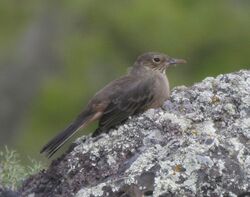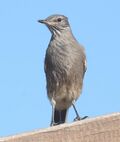Biology:Shrike-tyrant
From HandWiki
Short description: Genus of birds
| Shrike-tyrants | |
|---|---|

| |
| Great shrike-tyrant, (Agriornis lividus) | |
| Scientific classification | |
| Domain: | Eukaryota |
| Kingdom: | Animalia |
| Phylum: | Chordata |
| Class: | Aves |
| Order: | Passeriformes |
| Family: | Tyrannidae |
| Genus: | Agriornis Gould, 1839 |
| Type species | |
| Agriornis micropterus[1] Gould, 1839
| |
The shrike-tyrants are a genus, Agriornis, of birds in the tyrant flycatcher family Tyrannidae. The members of this genus are found in open habitats in western and southern South America, usually at high elevations. They are large and heavy billed by tyrant-flycatcher standards, and include the largest representative of the family, the great shrike-tyrant. These five species all have a dull brownish or greyish plumage. Despite their name any similarity with the shrikes is superficial. Many field guides note their greater (but also superficial) resemblance to thrushes.
Species
The genus contains the following 5 species:[2]
| Image | Common Name | Scientific name | Distribution |
|---|---|---|---|
 |
Black-billed shrike-tyrant | Agriornis montanus | Argentina, Bolivia, Chile, Colombia, Ecuador, Peru |
 |
Lesser shrike-tyrant | Agriornis murinus | northern Argentina, Bolivia and Paraguay. |
 |
White-tailed shrike-tyrant | Agriornis albicauda | Argentina, Bolivia, Chile, Ecuador, and Peru. |
 |
Grey-bellied shrike-tyrant | Agriornis microptera | Argentina, Bolivia, Chile, Paraguay, Peru, and Uruguay. |
 |
Great shrike-tyrant | Agriornis lividus | Chile and adjacent areas of south-western Argentina. |
References
- ↑ "Tyrannidae". The Trust for Avian Systematics. https://www.aviansystematics.org/4th-edition-checklist?viewfamilies=107.
- ↑ Gill, Frank; Donsker, David, eds (2019). "Tyrant flycatchers". World Bird List Version 9.2. International Ornithologists' Union. https://www.worldbirdnames.org/bow/flycatchers/. Retrieved 1 July 2019.
Wikidata ☰ Q518600 entry
 |

